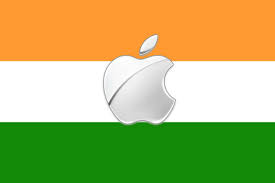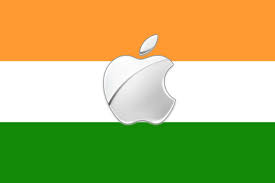
Apple Inc’s attempt to gain market share in the 1.3 billion market of India seems to be slipping and for good reason. The US tech giant recently brought down its revenue forecast for the complete year of 2018 primarily because of anticipated lower sale in emerging markets – mainly India.
Price is amongst the largest impediments for Apple gaining market share in India compared to its South Korean and Chinese rivals.
The average per capita yearly income in India is about $2,000 and even the cheapest of this new iPhones launched by Apple this tear - the XR costing 76,900 rupees ($1,058), is priced about double the price as a mumber of the alternatives for Indian consumers.
This is resulting in a fall in iPhone sale in India, says, Hong Kong-based Counterpoint Research. According to their estimate, Apple could face its first yearly decline in sale in India this year at about 2 million iPhones compared to about 3 million phones it sold in 2017 in the market.
Additionally, over half of the anticipated sale of iPhones would be accounted for the cheaper and older models.
But what is more intriguing is that in the third quarter of the current year, Apple has fallen behind rivals Samsung and China’s OnePlus even in the premium segment where smartphones are priced at more than $400.
However, Apple would be earning more from India as a company, driven by good Mac sales and the high unit price of iPhones. This means that the total revenues of $2 billion ramped up by Apple in 2017 was more than double that of OnePlus, which only sells mobile phones. But that gap is slated to shrink according to Counterpoint’s data.
10-15 percent of new customers in recent months have been defectors from Apple, said OnePlus’ India head Vikas Agarwal. This indicates that Apple is losing out on some of its loyalists who are not opting to upgrade their handsets.
But issues of Apple in India are beyond its price issues
There are a slew of regulatory issues for Apple in India and the company has also seen the exit of some of its top executives in India at the start of this year.
The company’s performance had nothing to do with the exits, said an Apple spokesman. Reports however suggested that the changing of its distribution system were probably linked to the departures of the executives.
The Indian government too has been focusing on policies to drive electronics producers into manufacturing locally. The measures include a steady growth in tariffs up the supply chain – starting with simple phone cases to sophisticated chipsets and boards.
This has seen millions being invested in their Indian operations and plants in the country by local brands such as Lava, and global smartphone firms including Samsung Electronics Co Ltd, Oppo and Xiaomi Corp. most have set up manufacturing units at places like Bengaluru and Delhi tech hub Noida.
In such a scenario, the only major smartphone marker that does not manufacture in India is Apple. The company only assembles only two low-cost older models through Wistron Corp in Bengaluru.
This means that about 70-80 percent of its phones of its iPhones have to be imported into India by Apple. This results in the company incurring high import duties that is passed on to the consumers making the phones costlier.
$749 or roughly 54,400 rupees is the cost of the basic iPhone XR model in the United States which is just two thirds of its retail price in India. Additionally, iPhoines are also subsidised in the US under deals with wireless carriers, which is not the case in India.
“Apple doesn’t have enough confidence ... in the Indian manufacturing system right now, to set up plants and move some of the manufacturing out of China,” said analyst Navkendar Singh of tech consulting firm IDC.
“In the process they are losing around 15-20 percent of their tax incentive ... which they could have passed on to the consumer.”
(Source:www.reutrers.com)
Price is amongst the largest impediments for Apple gaining market share in India compared to its South Korean and Chinese rivals.
The average per capita yearly income in India is about $2,000 and even the cheapest of this new iPhones launched by Apple this tear - the XR costing 76,900 rupees ($1,058), is priced about double the price as a mumber of the alternatives for Indian consumers.
This is resulting in a fall in iPhone sale in India, says, Hong Kong-based Counterpoint Research. According to their estimate, Apple could face its first yearly decline in sale in India this year at about 2 million iPhones compared to about 3 million phones it sold in 2017 in the market.
Additionally, over half of the anticipated sale of iPhones would be accounted for the cheaper and older models.
But what is more intriguing is that in the third quarter of the current year, Apple has fallen behind rivals Samsung and China’s OnePlus even in the premium segment where smartphones are priced at more than $400.
However, Apple would be earning more from India as a company, driven by good Mac sales and the high unit price of iPhones. This means that the total revenues of $2 billion ramped up by Apple in 2017 was more than double that of OnePlus, which only sells mobile phones. But that gap is slated to shrink according to Counterpoint’s data.
10-15 percent of new customers in recent months have been defectors from Apple, said OnePlus’ India head Vikas Agarwal. This indicates that Apple is losing out on some of its loyalists who are not opting to upgrade their handsets.
But issues of Apple in India are beyond its price issues
There are a slew of regulatory issues for Apple in India and the company has also seen the exit of some of its top executives in India at the start of this year.
The company’s performance had nothing to do with the exits, said an Apple spokesman. Reports however suggested that the changing of its distribution system were probably linked to the departures of the executives.
The Indian government too has been focusing on policies to drive electronics producers into manufacturing locally. The measures include a steady growth in tariffs up the supply chain – starting with simple phone cases to sophisticated chipsets and boards.
This has seen millions being invested in their Indian operations and plants in the country by local brands such as Lava, and global smartphone firms including Samsung Electronics Co Ltd, Oppo and Xiaomi Corp. most have set up manufacturing units at places like Bengaluru and Delhi tech hub Noida.
In such a scenario, the only major smartphone marker that does not manufacture in India is Apple. The company only assembles only two low-cost older models through Wistron Corp in Bengaluru.
This means that about 70-80 percent of its phones of its iPhones have to be imported into India by Apple. This results in the company incurring high import duties that is passed on to the consumers making the phones costlier.
$749 or roughly 54,400 rupees is the cost of the basic iPhone XR model in the United States which is just two thirds of its retail price in India. Additionally, iPhoines are also subsidised in the US under deals with wireless carriers, which is not the case in India.
“Apple doesn’t have enough confidence ... in the Indian manufacturing system right now, to set up plants and move some of the manufacturing out of China,” said analyst Navkendar Singh of tech consulting firm IDC.
“In the process they are losing around 15-20 percent of their tax incentive ... which they could have passed on to the consumer.”
(Source:www.reutrers.com)














